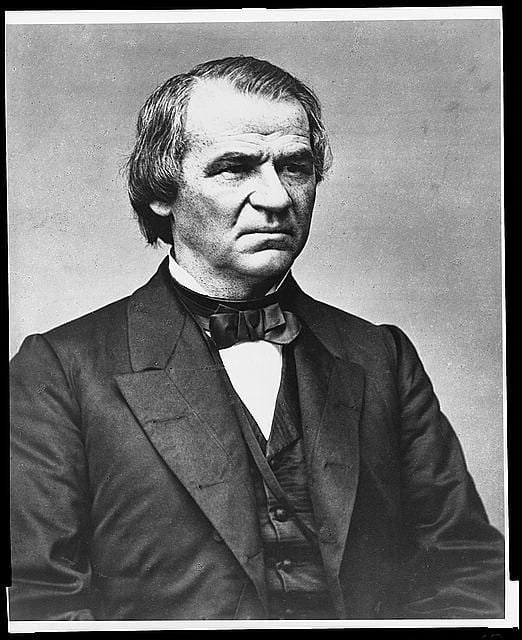




Andrew Johnson
Andrew Johnson, the 17th President of the United States, is often remembered for his tumultuous presidency during the Reconstruction era following the Civil War. Ascending to the presidency after the assassination of Abraham Lincoln, Johnson’s term was marked by significant conflict with Congress, leading to his impeachment. This biography explores Johnson’s life from his humble beginnings to his controversial presidency and legacy, providing an authoritative account of his contributions and challenges.
Early Life and Education
Birth and Family Background
Andrew Johnson was born on December 29, 1808, in Raleigh, North Carolina. He was the youngest of five children born to Jacob and Mary McDonough Johnson. His father, a laborer and sexton, died when Andrew was just three years old, leaving the family in dire financial straits. As a result, Johnson’s early life was marked by poverty and hardship (Trefousse, 1989).
Apprenticeship and Self-Education
At the age of ten, Johnson was apprenticed to a local tailor, where he worked long hours stitching clothes. Despite the demands of his apprenticeship, Johnson harbored a strong desire for education. He learned to read and write with the help of local townspeople who frequented the tailor shop. His interest in self-education continued throughout his life, making him one of the few self-taught presidents (Trefousse, 1989).
Marriage and Family
In 1826, Johnson moved to Greeneville, Tennessee, where he established his own tailoring business. That same year, he married Eliza McCardle, the daughter of a local shoemaker. Eliza played a significant role in Johnson’s life, helping him improve his reading and writing skills and supporting his political ambitions. The couple had five children: Martha, Charles, Mary, Robert, and Andrew Jr. (Trefousse, 1989).
Early Political Career
Entry into Politics
Johnson’s political career began in 1829 when he was elected as an alderman in Greeneville. His strong oratory skills and ability to connect with the common people quickly gained him recognition. In 1834, he was elected mayor of Greeneville, serving until 1837. Johnson’s political philosophy was rooted in Jacksonian Democracy, emphasizing the rights of the common man and limited government (Gara, 1991).
Tennessee State Legislature
In 1835, Johnson was elected to the Tennessee House of Representatives, where he served two terms. He then served in the Tennessee Senate from 1841 to 1843. Johnson’s tenure in the state legislature was marked by his advocacy for the interests of the working class and his opposition to elitism (Gara, 1991).
U.S. House of Representatives
Johnson’s success at the state level led to his election to the U.S. House of Representatives in 1843. He served five consecutive terms, during which he championed the Homestead Act, which aimed to provide free land to settlers in the West. Johnson believed that land ownership was key to economic independence and social mobility for the common man (Gara, 1991).
Governor of Tennessee
In 1853, Johnson was elected Governor of Tennessee, a position he held until 1857. As governor, he continued to advocate for the common people, promoting public education and fiscal responsibility. His tenure was also marked by efforts to reduce the influence of wealthy elites in state politics (Gara, 1991).
U.S. Senate
In 1857, Johnson was elected to the U.S. Senate, where he served until 1862. During his time in the Senate, Johnson emerged as a staunch defender of the Union, opposing secession despite his Southern background. His loyalty to the Union earned him the respect of President Abraham Lincoln, who appointed him as military governor of Tennessee in 1862 (Castel, 1979).
Vice Presidency and Ascension to the Presidency
Vice Presidency
In 1864, Johnson was selected as Abraham Lincoln’s running mate on the National Union ticket, a coalition of Republicans and War Democrats aimed at fostering national unity during the Civil War. Johnson’s selection was strategic, as he was a Southern Unionist Democrat, and his presence on the ticket was intended to appeal to war-weary voters in the border states and the South (Trefousse, 1989).
Assassination of Lincoln and Ascension
Lincoln’s assassination on April 14, 1865, thrust Johnson into the presidency at a critical juncture in American history. He took the oath of office on April 15, 1865, amid the nation’s mourning and uncertainty about the future of Reconstruction (Trefousse, 1989).
Presidency
Initial Policies and Reconstruction
Johnson initially promised to continue Lincoln’s policies and maintain a conciliatory approach toward the defeated South. However, his views on Reconstruction diverged significantly from those of the Radical Republicans in Congress. Johnson believed in a lenient Reconstruction, aimed at quickly restoring the Southern states to the Union with minimal changes to their pre-war social structures (Gara, 1991).
Presidential Reconstruction
Johnson’s plan for Reconstruction, known as Presidential Reconstruction, included the rapid restoration of Southern state governments, provided they accepted the abolition of slavery as mandated by the 13th Amendment. He offered amnesty and the return of property (except slaves) to most former Confederates who pledged loyalty to the Union (Stampp, 1965). However, his policies failed to protect the newly freed African Americans and allowed the resurgence of white supremacy in the South (Castel, 1979).
Conflict with Congress
Johnson’s lenient approach and his frequent vetoes of legislation aimed at securing civil rights for freed slaves led to a bitter conflict with Congress. The Radical Republicans, who controlled Congress, sought to implement a more stringent Reconstruction plan, ensuring civil rights and political participation for African Americans (Stampp, 1965).
Civil Rights Act and the 14th Amendment
In 1866, Congress passed the Civil Rights Act, which granted citizenship and equal protection under the law to African Americans. Johnson vetoed the bill, but Congress overrode his veto, marking the first time in American history that a major piece of legislation was enacted over a presidential veto (Stampp, 1965). This conflict set the stage for the passage of the 14th Amendment, which granted citizenship and equal protection to all persons born or naturalized in the United States. Johnson’s opposition to the amendment further alienated him from Congress (Castel, 1979).
Impeachment
The clash between Johnson and Congress culminated in his impeachment in 1868. The primary charge against him was his violation of the Tenure of Office Act, which restricted the president’s power to remove certain officeholders without the Senate’s approval. Johnson had attempted to remove Edwin M. Stanton, the Secretary of War and a Radical Republican ally, from office, leading to his impeachment by the House of Representatives (Trefousse, 1989).
Impeachment Trial
The impeachment trial in the Senate was a highly charged and partisan affair. Johnson narrowly avoided removal from office, as the Senate fell one vote short of the two-thirds majority required for conviction. Although he remained in office, his political power was effectively diminished for the remainder of his term (Castel, 1979).
Foreign Policy
Despite the domestic turmoil, Johnson’s presidency saw significant foreign policy achievements. Secretary of State William H. Seward, under Johnson’s administration, negotiated the purchase of Alaska from Russia in 1867, a transaction often referred to as “Seward’s Folly” at the time but later recognized as a strategic acquisition (Stampp, 1965).
Post-Presidency and Legacy
Return to the Senate
After leaving the White House in 1869, Johnson returned to Tennessee, where he continued to be involved in politics. In 1875, he was elected to the U.S. Senate, making him the only former president to serve in the Senate. His return to the Senate was brief, as he died on July 31, 1875, just a few months into his term (Trefousse, 1989).
Historical Assessment
Andrew Johnson’s presidency is often viewed critically by historians, primarily due to his lenient approach to Reconstruction and his failure to protect the rights of African Americans. His clashes with Congress and his impeachment trial have overshadowed other aspects of his career, including his earlier achievements as a champion of the common man and a defender of the Union (Gara, 1991).
Reconstruction and Civil Rights
Johnson’s lenient policies during Reconstruction allowed Southern states to enact “Black Codes,” restrictive laws that limited the freedoms of African Americans and sought to maintain the antebellum social order. This period of “Presidential Reconstruction” is widely criticized for its failure to provide lasting protections for freed slaves, setting back civil rights advancements (Stampp, 1965).
Contributions to American Politics
Despite his controversial presidency, Johnson’s contributions to American politics cannot be ignored. His rise from humble beginnings to the highest office in the land embodies the American ideal of self-made success. His advocacy for the Homestead Act and other populist measures reflected his commitment to the interests of the working class (Gara, 1991).
Final Summary
Andrew Johnson’s life and presidency were marked by significant achievements and profound controversies. From his early days as a tailor in North Carolina to his tumultuous term as president, Johnson’s career reflected his complex and often contradictory nature. His legacy as a champion of the common man is overshadowed by his failures during Reconstruction and his contentious relationship with Congress. Nevertheless, Johnson’s story is a testament to the challenges of leadership during one of the most critical periods in American history.
References
Castel, A. (1979). Andrew Johnson: A Biography. W.W. Norton.
Gara, L. (1991). The Presidency of Andrew Johnson. University Press of Kansas.
Stampp, K. M. (1965). The Era of Reconstruction, 1865-1877. Vintage Books.
Trefousse, H. L. (1989). Andrew Johnson: A Biography. W.W. Norton.
Trefousse, H. L. (1999). Impeachment of a President: Andrew Johnson, the Blacks, and Reconstruction. Fordham University Press.